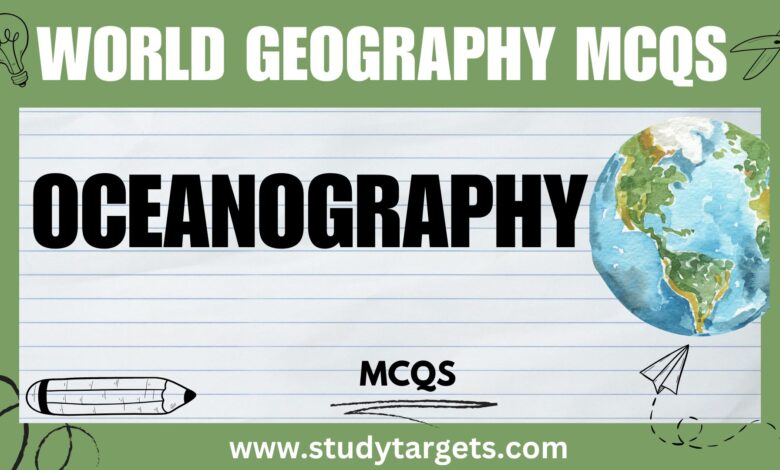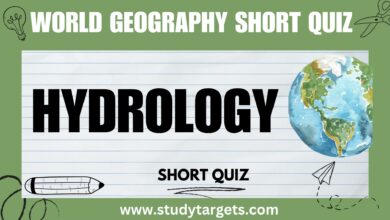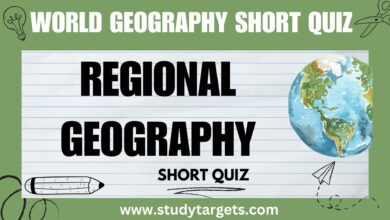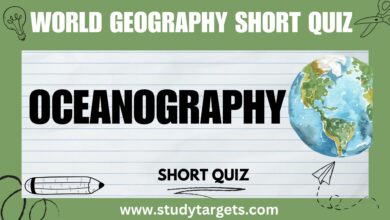MCQs : Oceanography : World Geography MCQs

Oceanography
1. What is the study of oceans and marine environments called?
A) Hydrology
B) Geology
C) Oceanography
D) Limnology
Answer: C) Oceanography
2. Which is the largest ocean on Earth?
A) Atlantic Ocean
B) Indian Ocean
C) Southern Ocean
D) Pacific Ocean
Answer: D) Pacific Ocean
3. What is the average salinity of ocean water?
A) 1%
B) 3.5%
C) 7%
D) 10%
Answer: B) 3.5%
4. Which ocean current helps regulate the climate of Western Europe?
A) Kuroshio Current
B) Gulf Stream
C) Humboldt Current
D) Benguela Current
Answer: B) Gulf Stream
5. The movement of ocean water due to differences in temperature and salinity is called:
A) Tidal flow
B) Thermohaline circulation
C) Wave action
D) Coastal drift
Answer: B) Thermohaline circulation
6. Which of the following features is found at the deepest part of the ocean?
A) Continental shelf
B) Mid-ocean ridge
C) Trench
D) Abyssal plain
Answer: C) Trench
7. Which oceanic phenomenon is caused by underwater earthquakes?
A) Tsunami
B) Cyclone
C) Monsoon
D) Hurricane
Answer: A) Tsunami
8. The process by which cold, nutrient-rich water rises to the surface is called:
A) Downwelling
B) Upwelling
C) Subduction
D) Deposition
Answer: B) Upwelling
9. Which of the following is a primary producer in marine ecosystems?
A) Fish
B) Seaweed
C) Plankton
D) Coral
Answer: C) Plankton
10. Which ocean is located between Africa, Asia, and Australia?
A) Atlantic Ocean
B) Indian Ocean
C) Arctic Ocean
D) Southern Ocean
Answer: B) Indian Ocean
11. What is the name of the deepest point in the world’s oceans?
A) Mariana Trench
B) Java Trench
C) Puerto Rico Trench
D) Tonga Trench
Answer: A) Mariana Trench
12. Which of the following influences the height of ocean tides?
A) Earth’s magnetic field
B) The position of the Moon
C) The speed of the Earth’s rotation
D) Oceanic trenches
Answer: B) The position of the Moon
13. Which type of ocean current moves parallel to the shore?
A) Surface current
B) Longshore current
C) Thermohaline current
D) Gyre
Answer: B) Longshore current
14. What is the primary cause of ocean waves?
A) Tidal forces
B) Wind
C) Earthquakes
D) Water density differences
Answer: B) Wind
15. The Sargasso Sea is located in which ocean?
A) Atlantic Ocean
B) Indian Ocean
C) Pacific Ocean
D) Southern Ocean
Answer: A) Atlantic Ocean
16. What is the name given to the transition zone between the ocean surface and the deep ocean?
A) Continental shelf
B) Thermocline
C) Abyssal plain
D) Seamount
Answer: B) Thermocline
17. Which ocean current is responsible for bringing cold water to the western coast of South America?
A) Kuroshio Current
B) Gulf Stream
C) Humboldt Current
D) Canary Current
Answer: C) Humboldt Current
18. What is the primary driver of deep ocean circulation?
A) Wind
B) Earth’s rotation
C) Differences in water density
D) Atmospheric pressure
Answer: C) Differences in water density
19. Which of the following is a feature of the ocean floor created by volcanic activity?
A) Trench
B) Seamount
C) Abyssal plain
D) Continental slope
Answer: B) Seamount
20. Which ocean lies at the North Pole?
A) Atlantic Ocean
B) Arctic Ocean
C) Pacific Ocean
D) Southern Ocean
Answer: B) Arctic Ocean




